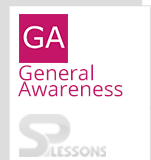 Introduction
Introduction
General Awareness is an important component of most of the competitive exams for employment in the government sector in India. The article UPSC NDA and NA Mains General Awareness Quiz 1 presents questions related to IBPS PO, SSC CGL, SSC MTS, SSC CHSL, SEBI Grade A, Indian Bank PGDBF PO, LIC HFL, NIACL Assistant, RRB Assistant, RRB PO, SBI Clerk, SBI PO, RBI Grade B and BOB PGDBF PO. The article UPSC NDA and NA Mains General Awareness Quiz 1 have been designed keeping in view the significant role of General Awareness sections in the scoring of competitive exams. UPSC NDA and NA Mains General Awareness Quiz 1 is very useful to crack the General Awareness sections of several competitive exams.
 Quiz
Quiz
1. Consider the following statement (s) related to Mughal Emperor Jahangir.
I. Jahangir claimed that he could distinguish the work of different artists in a single picture.
II. Painting was at its climax during his reign.
Which of the above statements is/are correct?
- A. Only I
B. Only II
C. Both I and II
D. None of the above
- A. Shah Muhammad
B. Shah Parvez
C. Shah Abbas
D. Shah Raza
- A. Only I
B. Only II
C. Both I and II
D. Neither I nor II
- A. Only I
B. Only II
C. Both I and II
D. Neither I nor II
- A. Babur-Humayun-Akbar-Jahangir
B. Humayun-Babur-Akbar-Jahangir
C. Babur-Humayun-Jahangir-Akbar
D. Humayun-Babur-Jahangir-Akbar
1. Which of the following the tributaries of the river Ganga originates in the plains?
- A. Yamuna
B. Kosi
C. Son
D. Gomti
- A. 2,000
B. 4,000
C. 3,000
D. 5,000
- A. 55%
B. 65%
C. 75%
D. 85%
- A. Irrigation
B. Domestic use
C. Industries
D. None of the above
- A. Andhra Pradesh
B. Maharashtra
C. Karnataka
D. Gujarat
1. Which of the following elections is not conducted under the supervision of the Election Commission of India?
- A. Election of Vice President of India
B. Election of States legislatures
C. Election of local bodies
D. Election of Union Legislature
- A. First Amendment
B. Eighth Amendment
C. Ninth Amendment
D. Forty Second Amendment
- A. President
B. Prime Minister
C. Chief Justice of India
D. Vice President of India
- A. Fundamental Rights
B. Fundamental Duties
C. Directive Principles of State Policy
D. Fundamental Rights and Fundamental Duties
- A. Ernest Barker
B. BR Ambedkar
C. KM Munshi
D. Jawahar Lal Nehru



